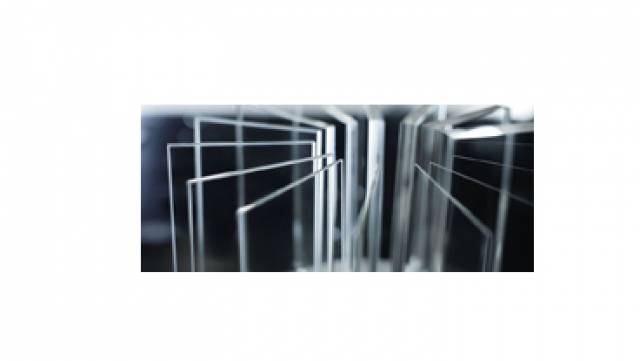BOROFLOAT® by SCHOTT is extremely durable
SCHOTT BOROFLOAT® is not only extremely durable, but also has an expansion coefficient matched for the semiconductor, therefore suited as a basis for these high tech systems than any other material.
A revolution is on the horizon: Cars of the future will contain more glass parts than you may think – a Hamburg company conquers new fields with special technical glass. The display screen, the touchscreen GPS and the panoramic sunroof all have one thing in common – they are made of glass.
But when it comes to building cars, glass isn’t just important in the obvious areas, but also where most would probably least expect it – ‘under the hood’: It helps regulate the engine’s fuel injection pump, monitor tire pressure and activate ABS and the airbag at the right time. After all, the acceleration and pressure sensors controlling these processes, so-called MEMS sensors (micro-electro-mechanical systems), are made from silicon and glass. A type of glass needs to be used that can withstand the extreme temperature fluctuations and mechanical stress in the engine compartment: Solution BOROFLOAT®.
This special float glass by SCHOTT is not only extremely durable, but also has an expansion coefficient matched for the semiconductor – to ensure that the sensor is also reliable in extreme heat or cold. A piece of glass just a few millimetres in size is more suited as a basis for these high tech systems than any other material and that´s just the beginning.
In autonomous cars of the future, glass will help guarantee higher safety. Is the road ahead clear? Is a pedestrian crossing the street? How far away is the next car in front? Lidar systems continuously scan the surroundings at 360 degrees to answer these questions, putting high demands on the glass being used. The extreme optical purity, high durability and permeability of infrared rays makes BOROFLOAT® predestined for these types of systems. Thanks to the good dielectric properties, BOROFLOAT® is also the perfect substrate for antenna systems, which will be used by the ‘connected cars’ of the future to communicate with each other and traffic management systems. Even at GHz frequencies, transmission and reception are not impaired.
“Glass is the perfect material whenever shape accuracy, compatibility with semiconductors and high transparency are key,” says Ulrich Schuster, CEO at Schröder Spezialglas in Ellerau near Hamburg. His company cuts, bores, mills, bends and shapes high precision technical glass for virtually any conceivable application. That’s where BOROFLOAT® is the perfect basis: High chemical and mechanical resistance, unmatched durability and ideal recyclability – the special float glass by SCHOTT is the leader when it comes to breaking new ground and tapping new applications. The revolution, according to the expert Ulrich Schuster, is already under way: “Glass will be replacing plastic more and more.”
This also applies to lighting in the automotive industry: New concepts in this area are – again – using glass: LED, matrix LED or laser headlights use special filters to improve night vision, making it easier to detect obstacles in the road without blinding oncoming traffic. Without a tough, super-transparent glass like BOROFLOAT® these systems can’t be implemented to withstand the heat a laser generates and guarantee the great headlight range.
BOROFLOAT® also opens up entirely new shapes for holographic head-up displays, which show turns or warnings about obstacles directly on the windshield within the driver’s view (‘augmented reality‘) – this is where the light weight and extremely high transparency of this unique flat glass will help to implement future projection systems in very small areas.
Minimal bend radii, bores in the microscopic range, sophisticated cut-outs: Can glass actually stand up to these requirements?
“With the right tool we can turn special float glass into virtually anything”, says Ulrich Schuster. “BOROFLOAT® is excellent for laser machining. It’s virtually challenging us to come up with new projects.”
BOROFLOAT® is made using a micro-float process where the glass ribbon floats on top of a bath of molten tin to then cool down. Unlike other glass, BOROFLOAT® is ‘floated’ at temperatures that are up to 200°C (392°F) higher with variances under half a degree. This process, which also precisely controls the thickness of the glass, guarantees perfect homogeneity, outstanding flatness and the mirror-like surface of the special float glass by SCHOTT. It is also the basis for the high optical quality.
Ulrich Schuster explains “soda lime lenses develop a whitish-grey build-up after a year or two and they become blind.
However by using BOROFLOAT® lasting brightness can be achieved as this hydrolysis or glass corrosion does not occur.”
The extreme transparency and colourlessness is especially important in areas where light is key.
“We have been using this special float glass for over two decades now,” Ulrich Schuster says. “We’ve used it to produce parts and technical glass that were unrivalled by others.“ This was primarily the case because Schröder Spezialglas has always been able to count on one thing: The quality of its material. “BOROFLOAT® our company wouldn’t even exist.“




